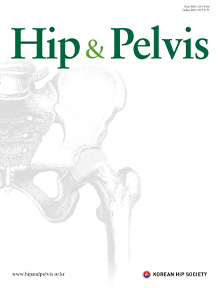Original Article
Hip Pelvis 2013; 25(4): 267-273
Published online December 1, 2013
https://doi.org/10.5371/hp.2013.25.4.267
© The Korean Hip Society
The Analysis of Postoperative Mortality after Bipolar Hemiarthroplasty for Hip Fractures in the Elderly
Correspondence to : Hyeungjune Kim, MD
Department of Orthopedic Surgery, Konkuk University School of Medicine, 620-5 Gyohyun-dong, Chungju 380-704, Korea
TEL: +82-43-840-8250 FAX: +82-43-844-7300
E-mail: hjune7610@naver.com
This is an Open Access article distributed under the terms of the Creative Commons Attribution Non-Commercial License (http://creativecommons.org/licenses/by-nc/3.0) which permits unrestricted non-commercial use, distribution, and reproduction in any medium, provided the original work is properly cited.
Purpose: This study evaluated the rate of mortality and analyzed the associated risk factors in elderly patients treated with bipolar hemiarthroplaty for the hip fractures.
Materials and Methods: Between March 1994 and March 2010, the clinical records of 246 patients(278 cases) older than 75 years of age who underwent bipolar hemiarthroplaty after hip fractures were reviewed. The mean age of the subjects was 83.7 years(75-103 years). The relationship between the postoperative one year mortality and the related factors (age, gender, type of hip fractures, the timing of surgery, the associated medical condition, ASA grade, osteoporosis, walking ability and residence type) were analyzed. The subjects were divided into the dead group and survivor group.
Results: The mean postoperative mortality rate within 1 year was 17.2%(48 cases). The highest mortality rate was observed at postoperative 3 months(9.7%, 27 cases), followed in order by between 4 and 6 months(5.4%, 15 cases) and 7 and 12 months(2.1%, 6 cases). The postoperative mortality rate within 1 year was affected by the timing of the operation, ASA grade, patient’s walking ability, and residence type, but there were no significant difference of the other factors, such as age, gender, osteoporosis, and type of hip fractures.
Conclusion: The ASA grade, timing of the operation, walking ability, and residence type are factors associated with the mortality rate in elderly patients with hip fractures.
Keywords Elderly, Hip fracture, Bipolar hemiarthroplasty, Mortality rate
Article
Original Article
Hip Pelvis 2013; 25(4): 267-273
Published online December 1, 2013 https://doi.org/10.5371/hp.2013.25.4.267
Copyright © The Korean Hip Society.
The Analysis of Postoperative Mortality after Bipolar Hemiarthroplasty for Hip Fractures in the Elderly
Dukhwan Kho, MD, Kyoungmo Nam, MD, Sunghak Oh, MD, Hyeungjune Kim, MD
Department of Orthopedic Surgery, Chungju Hospital, Konkuk University School of Medicine, Chungju, Korea
Correspondence to:Hyeungjune Kim, MD
Department of Orthopedic Surgery, Konkuk University School of Medicine, 620-5 Gyohyun-dong, Chungju 380-704, Korea
TEL: +82-43-840-8250 FAX: +82-43-844-7300
E-mail: hjune7610@naver.com
This is an Open Access article distributed under the terms of the Creative Commons Attribution Non-Commercial License (http://creativecommons.org/licenses/by-nc/3.0) which permits unrestricted non-commercial use, distribution, and reproduction in any medium, provided the original work is properly cited.
Abstract
Purpose: This study evaluated the rate of mortality and analyzed the associated risk factors in elderly patients treated with bipolar hemiarthroplaty for the hip fractures.
Materials and Methods: Between March 1994 and March 2010, the clinical records of 246 patients(278 cases) older than 75 years of age who underwent bipolar hemiarthroplaty after hip fractures were reviewed. The mean age of the subjects was 83.7 years(75-103 years). The relationship between the postoperative one year mortality and the related factors (age, gender, type of hip fractures, the timing of surgery, the associated medical condition, ASA grade, osteoporosis, walking ability and residence type) were analyzed. The subjects were divided into the dead group and survivor group.
Results: The mean postoperative mortality rate within 1 year was 17.2%(48 cases). The highest mortality rate was observed at postoperative 3 months(9.7%, 27 cases), followed in order by between 4 and 6 months(5.4%, 15 cases) and 7 and 12 months(2.1%, 6 cases). The postoperative mortality rate within 1 year was affected by the timing of the operation, ASA grade, patient’s walking ability, and residence type, but there were no significant difference of the other factors, such as age, gender, osteoporosis, and type of hip fractures.
Conclusion: The ASA grade, timing of the operation, walking ability, and residence type are factors associated with the mortality rate in elderly patients with hip fractures.
Keywords: Elderly, Hip fracture, Bipolar hemiarthroplasty, Mortality rate

Article Tools
Stats or Metrics
Related articles in H&P
-
Bipolar Hemiarthroplasty for Femoral Neck Fractures in the Elderly
Ju-Yong Shin, M.D., Hyeung-June Kim, M.D., Eung-Sik Kim, M.D., Dong-Heon Kim, M.D.
J Korean Hip Soc 2008; 20(3): 188-196 -
Cementless Zweymuller Stem for the Treatment of the Hip Fracture in Patients Older than 80 with Severe Osteoporosis: Case Control Study with Cemented Stem
Jun Dong Chang, Je Hyun Yoo, Ki Young Chang and Byeong Mun Park
J Korean Hip Soc 2006; 18(5): 447-453 -
Bone Health Evaluations and Secondary Fragility Fractures in Hip Fracture Patients
Emily M. Pflug, MD, Ariana Lott, MD, Sanjit R. Konda, MD, Philipp Leucht, MD, PhD, Nirmal Tejwani, MD, Kenneth A. Egol, MD
Hip Pelvis 2024; 36(1): 55-61




 PDF
PDF Standard view
Standard view Export citation
Export citation Share
Share  Previous Article
Previous Article



